 After two great sailing days, we are securely anchored in Rose Inlet with the wind still blowing. If the weather permits, Friday morning, July 29th, promises to be the highlight of our exploration of Gwaii Haanas National Park Reserve, Marine Conservation Area Reserve, and Haida Heritage Site. For the past week we have been discovering this “Place of Beauty”, and thus far have not been disappointed (except for our Skedans sinking…..). These islands on the edge have shown us dramatic evidence of glaciers at many turns of Cat’s Cradle’s bow – jagged mountain peaks, sandy beaches, rounded islands, verdant valleys, mucky mudflats and undulating fiords, all formed over the past 2 million years by receding glaciers. Now we will visit S’gang G’waay World Heritage Site.
After two great sailing days, we are securely anchored in Rose Inlet with the wind still blowing. If the weather permits, Friday morning, July 29th, promises to be the highlight of our exploration of Gwaii Haanas National Park Reserve, Marine Conservation Area Reserve, and Haida Heritage Site. For the past week we have been discovering this “Place of Beauty”, and thus far have not been disappointed (except for our Skedans sinking…..). These islands on the edge have shown us dramatic evidence of glaciers at many turns of Cat’s Cradle’s bow – jagged mountain peaks, sandy beaches, rounded islands, verdant valleys, mucky mudflats and undulating fiords, all formed over the past 2 million years by receding glaciers. Now we will visit S’gang G’waay World Heritage Site.
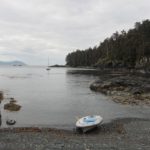 At 9:30 a.m.we anchor in Gray’s Bay after calling on VHF Channel 6 asking the watchmen if we could come ashore on the south beach. A young woman in training to become a watchperson, Winona, cheerfully greets us and we walk to the watchmen’s cabin along a muddy trail with huge skunk cabbage lining the edges. We meet Ken, our Haida guide, and 6 people who have just flown in from Vancouver and are on a whirlwind tour. We are then off to view examples of the creative artistic genius of the Haida people and to learn about the poles which still stand where they were raised. This site is recognized as having international importance for its artistic heritage and certainly deserves the status of a World Heritage Site, a title given to it in 1981 by the United Nations. As such, it ranks alongside the pyramids of Egypt, recognizing a civilization that almost disappeared. This was the last home of the Haida nation of the southern Gwaii Haanas region.
At 9:30 a.m.we anchor in Gray’s Bay after calling on VHF Channel 6 asking the watchmen if we could come ashore on the south beach. A young woman in training to become a watchperson, Winona, cheerfully greets us and we walk to the watchmen’s cabin along a muddy trail with huge skunk cabbage lining the edges. We meet Ken, our Haida guide, and 6 people who have just flown in from Vancouver and are on a whirlwind tour. We are then off to view examples of the creative artistic genius of the Haida people and to learn about the poles which still stand where they were raised. This site is recognized as having international importance for its artistic heritage and certainly deserves the status of a World Heritage Site, a title given to it in 1981 by the United Nations. As such, it ranks alongside the pyramids of Egypt, recognizing a civilization that almost disappeared. This was the last home of the Haida nation of the southern Gwaii Haanas region.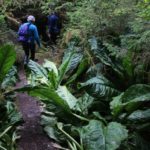
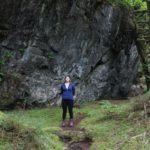 It was the primary residence for over 2,000 years; inhabitants left in the summer in massive cedar canoes to hunt, fish and gather edible plants and in the winter months they had time to carve, construct and have social ceremonies.
It was the primary residence for over 2,000 years; inhabitants left in the summer in massive cedar canoes to hunt, fish and gather edible plants and in the winter months they had time to carve, construct and have social ceremonies.
We felt humbled as we walked along the curving path marked by bleached clam shells as Ken related stories of the past which link us to the rich Haida oral traditions. Weathered carved faces looked out to sea as we gazed inward at each pole and listened to some of many stories such as this one:
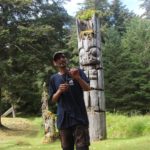
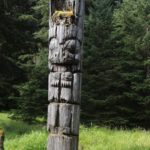 A man married a woman of the Raven clan; he was of the other clan, the Bear clan, which is proper for all true Haida. They decided to move to another island far away and so they did. After many months, the man grew lonesome for his home and he told his wife he would go home and then return in a few months, and so he did. Meanwhile, missing her husband, his wife fell in love with a supernatural bear and soon, as these things happen, she bore two handsome bear cubs. When her husband returned after his two month visit, he found his wife with the two babies. He was surprised. But, then he understood. With supernatural bears, real things can happen faster than one would think.
A man married a woman of the Raven clan; he was of the other clan, the Bear clan, which is proper for all true Haida. They decided to move to another island far away and so they did. After many months, the man grew lonesome for his home and he told his wife he would go home and then return in a few months, and so he did. Meanwhile, missing her husband, his wife fell in love with a supernatural bear and soon, as these things happen, she bore two handsome bear cubs. When her husband returned after his two month visit, he found his wife with the two babies. He was surprised. But, then he understood. With supernatural bears, real things can happen faster than one would think.
(Note the two baby faces on the paws of the bear behind Ken, our storyteller.)
Most of the poles are mortuary, although a few are memorial. Mortuary poles were carved when a person of high status died. His body was bound tightly with woven cedar cords and stored in a bentwood box for 2-3 years (enough time to have the mortuary pole carved) in the woods. When the pole was finished, complete with the crests of the deceased person, the bentwood box was placed in the cavity at the top of the pole with a plaque in front of cavity to cover the box from view. A board was placed on top to keep the rain out, and rocks were also placed on top of the board to keep it in place. Mortuary poles were carved with the base of the tree as the top of the pole, and they were much shorter than memorial poles (used to remember those who never never returned home) or house frontal poles.
The S’gang G’waay poles are carved with animal, human and supernatural figures, and each pole tells a story of family history and lineage. Unfortunately much of the information regarding crests and the people honored is missing because the clan historians, and others who remembered the tales of the deceased, died tragically as a result of smallpox epidemics.
Click here for link to higher resolution photo.
Memorial poles usually had a single crest figure at the base of the pole and a figure at the top representing one of the two main clans of S’gaang G’waay: the raven or the eagle. The middle section of the pole was left uncarved, or it was carved with potlatch rings, indicating the number of potlatches the deceased person had hosted (a sign of his wealth and high status).
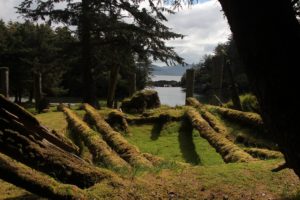 We viewed the moss-covered site of Chief Koya’s house which had six beams and used an elaborate longhouse corner post joinery in its construction, unique to the Haida. When a person of high ranking had accumulated enough wealth to raise a house, people of the opposite clan gathered the wood and workforce and dug the deep pit in one day. The pit had tiers from the outer walls to the center and was the ceremonial meeting place of the village.
We viewed the moss-covered site of Chief Koya’s house which had six beams and used an elaborate longhouse corner post joinery in its construction, unique to the Haida. When a person of high ranking had accumulated enough wealth to raise a house, people of the opposite clan gathered the wood and workforce and dug the deep pit in one day. The pit had tiers from the outer walls to the center and was the ceremonial meeting place of the village.
With the tour going into its third hour, we excused ourselves in order to begin our overnight crossing of the Hecate Strait and Queen Charlotte Sound. With our heads full of Haida historical stories and our camera loaded with Heritage Site images, we unfurled the jib and plotted an overnight course – straight to Bull Harbor on northern Vancouver Island.
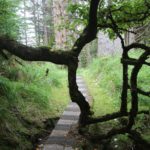



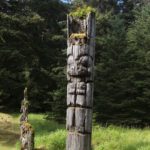
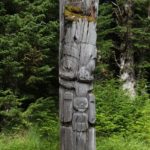




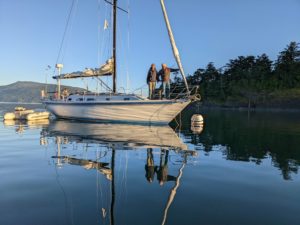
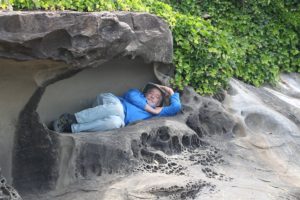
susan nevin
4 Aug 2016Glad you two are doing well and having a great time. So many sailing challenges! Leslie, do you love sailing? It looks like you do!
The Calapooia awaits you…
Will Scott’s family be joining you soon?
Love from S and K
Colin
4 Aug 2016Dear Val and Leslie: More thanks for your important contribution to sarcophagology and furnerary history.
Julia R
15 Aug 2016What a privilege to see and feel that ancient place that is Haida Gwaii. Your descriptions are so good I can almost feel an echo of that place.
Love, Julia